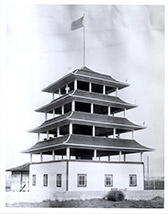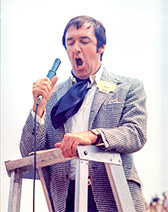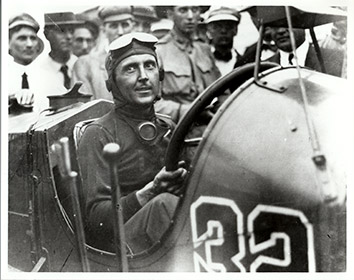Subscriber Benefit
As a subscriber you can listen to articles at work, in the car, or while you work out. Subscribe NowIn the beginning—meaning the day they ran the first Indianapolis 500—the American flag had only 46 stars. The World Series had been played only seven times, won twice by the Chicago Cubs.
 In other words, the first race day dawned a long time ago.
In other words, the first race day dawned a long time ago.
How long? To get a sense of time passed on 16th Street, we can match some of the most significant moments in the race’s formative years with some of the world’s most significant events.
Ladies and gentlemen, start your history books.
May 30, 1911: Ray Harroun wins the inaugural Indianapolis 500.
The next day, a dazzling ship is launched and touches water for the first time in Belfast, Ireland. It is called Titanic.
May 30, 1912: Ralph DePalma builds a 5-1/2-lap lead in a dominating performance for the ages, but a connecting rod breaks on lap 197 and makes a most fortunate winner out of Joe Dawson.
The same day, Wilbur Wright dies of typhoid fever at the age of 45, only nine years after he and brother Orville took flight.
May 30, 1913: Frenchman Jules Goux, reportedly sipping champagne at pit stops, is the winner. New to the landscape is a pagoda near the finish line. That building, and its later replacement, will become icons.
 The Speedway’s first pagoda made its debut at the 1913 race. (Photo courtesy of the Indianapolis Motor Speedway)
The Speedway’s first pagoda made its debut at the 1913 race. (Photo courtesy of the Indianapolis Motor Speedway)The same week, a 14-year-old boy born in Austria-Hungary moves to Germany. Adolf Hitler.
May 30, 1931: Louis Schneider wins the 19th Indianapolis 500 on a day darkened by the most bizarre death in the track’s history. An accident in the fourth turn sends a wheel flying off Speedway property; it kills Wilbur Brink, an 11-year-old playing in his yard on Georgetown Road.
The month begins with the dedication of the Empire State Building as the world’s tallest building—and future prop for King Kong.
May 30, 1936: To quench his post-race thirst, winner Louis Meyer gulps buttermilk. A tradition is born.
The same month, the Yankees insert a touted rookie into their lineup. In his debut against the St. Louis Browns, Joe DiMaggio gets three hits, including a triple.
May 30, 1946: A bedraggled Speedway is reborn, saved by Tony Hulman. George Robson wins the first race since 1941, and the program includes the addition of a catchy song, “Back Home Again in Indiana.”
Three weeks before, two Japanese men take borrowed capital of $1,500 and start the Tokyo Telecommunications Engineering Corp., with only 20 employees. Their first venture, a rice cooker, is an abysmal failure. The firm will one day be called Sony.
May 30, 1960: In one of the fiercest two-driver duels in Indy 500 history, Jim Rathmann beats Rodger Ward, after a race with 29 lead changes. They swap the lead eight times in the final 31 laps.
The same May, Nashville, Tenn.—after prolonged sit-ins by students—becomes the first major southern U.S. city to desegregate its lunch counters.
May 30, 1964: In one of the bloodiest race days in history, driver Eddie Sachs and Dave MacDonald are killed in a horrific crash in the fourth turn of the second lap. A.J. Foyt gets his second victory, the last by a front-engine car.
The month begins with several hundred young people marching in Times Square. Thus, the nation sees its first student protests against the Vietnam War. But not the last.
May 30, 1966: Graham Hill wins the 50th Indianapolis 500.
The first Super Bowl won’t be played for another 7-1/2 months.
May 31, 1967: Andy Granatelli brings a revolutionary turbine engine to the race, and his driver, Parnelli Jones, is on the verge of running away with a victory—until a $6 transmission bearing fails with four laps to go. Foyt wins for the third time.
Three weeks before, Muhammad Ali is indicted for refusing to be drafted into the U.S. Army. He is convicted in June and does not return to the ring for more than three years.
 Jim Nabors had to consult written lyrics in 1972, the first time he sang “(Back Home Again in) Indiana,” because he was a last-minute fill-in. (Photo courtesy of the Indianapolis Motor Speedway)
Jim Nabors had to consult written lyrics in 1972, the first time he sang “(Back Home Again in) Indiana,” because he was a last-minute fill-in. (Photo courtesy of the Indianapolis Motor Speedway)May 27, 1972: Mark Donohue wins an Indianapolis 500 that includes the singing of “(Back Home Again in) Indiana” by a man who isn’t asked to perform it until the morning of the race. Jim Nabors goes on without a rehearsal, the song lyrics written out. He does OK.
The next night, several men successfully break into the office of the Democratic National Committee in a Washington, D.C., building called The Watergate, installing listening devices on some of the phones. They return to do more espionage in June. The second mission doesn’t turn out so well.
May 29, 1977: Foyt becomes the first man to win the Indianapolis 500 four times.
Four days earlier, a movie opens to considerable buzz. The public lines up to see “Star Wars.”
May 24, 1981: In arguably the most controversial Indy 500, the Borg-Warner trophy changes hands twice—after the checkered flag. Bobby Unser is first to the finish, but is dropped to second in the official standings the next morning for an illegal pass coming out of the pits, making Mario Andretti the winner. After a lengthy appeal, Unser is reinstated on Oct. 9, more than four months after he steered into Victory Lane.
Two weeks after the race, the Centers for Disease Control reports for the first time of a new virus striking gay men in Los Angeles. The first headline for AIDS.
May 24, 1987: Al Unser Sr., after entering the month without a sponsor or a ride, joins Foyt as a four-time winner in a heartwarming upset.
The same month, Andy Murray is born in Great Britain, and Novak Djokovic in Serbia. Two tennis players who will fight for the No. 1 ranking globally in 2016 come into the world within a week of each other.
May 26, 1991: Rick Mears becomes the third man to win the race four times.
Seventeen days later, Michael Jordan gets his first NBA title.
Those were among the last peaceful days in Indy car racing, with the dark clouds of civil war on the horizon. But now the race roars on, having seen 18 presidents of the United States. No. 100 should not only rekindle the magic, but remind us how much history one event in May can share, when it’s happened 99 times.•
__________
Lopresti is a lifelong resident of Richmond and a graduate of Ball State University. He was a columnist for USA Today and Gannett newspapers for 31 years; he covered 34 Final Fours, 30 Super Bowls, 32 World Series and 16 Olympics. His column appears weekly. He can be reached at mlopresti@ibj.com.
Please enable JavaScript to view this content.

